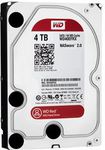If you are in the market for hard disks you know what these are. Specifically designed for torrent-leeching, video-capturing, must-download-every-you-tube-video-ever-made people like me and you. I've been waiting for a good offer like this to come up to replace my aging 2TB WD green, which died last week :(
Limit of 2 per customer = Max of 8TB per order :P
$7.20 local shipping (VIC)
Best Price on:
staticice.com.au $228
ebay.com.au $253
newegg.com $199 USD
amazon.com $184 USD
Buy some and flog 'em on ebay if you're bored!
If you prefer Seagate, here's a good deal:
Seagate Barracuda 4TB 5900RPM 64MB SATA3/6Gb $187
or cheap SSDs:
SanDisk Ultra Plus 128GB SSD $79
Kingston SSDNow V300 120GB (SV300S37A/120G) 2.5" SSD $90
Deals end on: 28/04/2014 7:00:00 AM


Not worth the hassle after eBay and PayPal fees